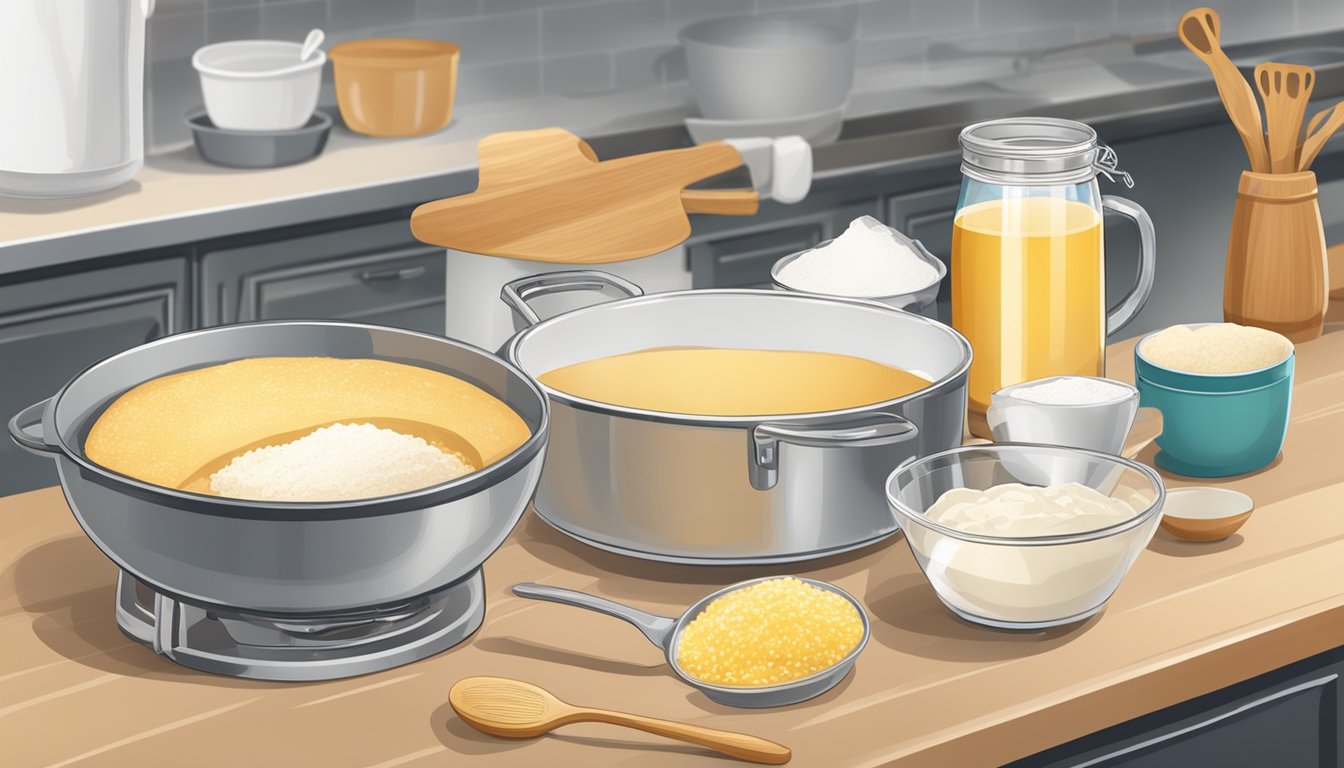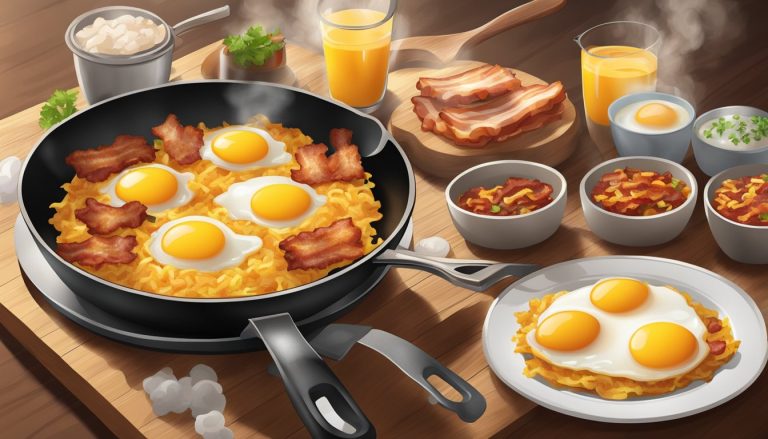English crumpets are a beloved breakfast staple, renowned for their distinctive texture and flavor. These small, round griddle cakes feature a soft, spongy interior and a crispy exterior dotted with tiny holes perfect for soaking up butter and jam. Making homemade crumpets is simpler than many people realize, requiring just a few basic ingredients and some patience.
Traditional English crumpets have been enjoyed for centuries, and their popularity has only grown over time. The process of crafting these delightful treats at home allows for a fresher, more authentic experience compared to store-bought versions. By creating crumpets from scratch, breakfast enthusiasts can control the ingredients and customize the flavor to their liking.
Preparing homemade crumpets involves creating a yeast-based batter, letting it rise, and then cooking the mixture in special rings on a griddle or skillet. The result is a batch of warm, golden crumpets ready to be served with an array of sweet or savory toppings. This time-honored recipe brings a touch of English tradition to any breakfast table, offering a delicious and satisfying start to the day.
Understanding Crumpets
Crumpets are a beloved British breakfast and teatime staple. These small, round griddle cakes feature a distinctive honeycomb-like texture on top and a soft, spongy interior that soaks up butter and spreads beautifully.
History and Origin
Crumpets have a rich history dating back to Anglo-Saxon times. The name likely derives from the Old English word “crompeht,” meaning curled-up or wrinkled. Originally flat and hard, crumpets evolved into their current form during the Victorian era.
The invention of baking powder in the 19th century revolutionized crumpet production. This leavening agent created the signature holes on top, allowing butter to seep through. By the 1920s, crumpets became widely available in bakeries and stores across Great Britain.
Crumpet rings, metal or silicone molds used to shape the batter, were introduced in the early 20th century. These tools helped standardize the size and shape of crumpets, making them easier to produce on a larger scale.
Crumpets Vs. English Muffins
While often confused, crumpets and English muffins have distinct differences:
- Texture: Crumpets are spongier with visible holes on top. English muffins are denser with a rougher exterior.
- Cooking method: Crumpets are cooked on one side only. English muffins are cooked on both sides and often split before toasting.
- Serving style: Crumpets are typically eaten whole. English muffins are usually split and filled.
- Batter consistency: Crumpet batter is thinner, while English muffin dough is thicker and kneaded.
Both are delicious breakfast options, but crumpets offer a unique texture and eating experience.
The Role of Crumpets in British Cuisine
Crumpets hold a special place in British food culture. They are a quintessential component of afternoon tea, often served alongside scones and finger sandwiches. Many Britons enjoy crumpets for breakfast or as a comforting snack throughout the day.
Traditional toppings include:
- Butter
- Jam or marmalade
- Honey
- Cheese (melted or spread)
Crumpets are versatile and can be adapted to both sweet and savory preparations. Some modern variations include eggs benedict on crumpets or crumpet pizzas. Their popularity has spread beyond Great Britain, with crumpets now enjoyed in many Commonwealth countries and beyond.
Ingredients Breakdown
Crafting authentic English crumpets requires a careful selection of ingredients. Each component plays a crucial role in achieving the perfect texture and flavor.
Flour Choices
All-purpose flour serves as the primary base for crumpet batter. It provides structure and creates the characteristic chewy texture. Some recipes incorporate bread flour for added strength and elasticity. A blend of 2 cups all-purpose flour with 1/2 cup bread flour can enhance the crumpets’ structure. Whole wheat flour may be substituted for a portion of the all-purpose flour to add a nutty flavor and boost nutritional value.
Leavening Agents
Active dry yeast is the key leavening agent in crumpets. It creates the signature bubbles and contributes to the distinctive flavor. Typically, 1-1.5 teaspoons of yeast are used per batch. Some recipes include baking powder as an additional leavening agent. A combination of 1 teaspoon baking powder with the yeast can provide extra lift and ensure a light, airy texture.
Dairy Additions
Whole milk is essential for achieving rich flavor and tender crumpets. It adds moisture and helps create a smooth batter. For a single batch, 1-1.5 cups of milk are typically used. Some recipes suggest warming the milk slightly before adding it to the dry ingredients. This can help activate the yeast more effectively.
Seasonings and Sweeteners
Salt is crucial for enhancing flavor. About 1/2 teaspoon of kosher salt per batch is standard. It balances the sweetness and rounds out the overall taste profile. Granulated sugar, usually 1-2 teaspoons, feeds the yeast and adds a subtle sweetness. Some recipes incorporate a small amount of melted butter for richness. Variations may include a pinch of cinnamon or vanilla extract for added depth of flavor.
Making the Batter
Creating the perfect crumpet batter is crucial for achieving those characteristic holes and spongy texture. The process involves carefully combining ingredients and allowing time for fermentation.
Mixing the Ingredients
In a large bowl, combine 225g of strong white bread flour with 1 teaspoon of salt. In a separate container, mix 1 teaspoon of caster sugar with 7g of instant yeast and 275ml of warm milk. Pour the liquid mixture into the flour and whisk vigorously until smooth. Add 75ml of warm water and mix again.
For a vegan version, substitute the milk with plant-based alternatives like soy or oat milk. Ensure all ingredients are at room temperature for optimal yeast activation.
Proofing: Creating the Texture
Cover the bowl with a damp cloth and place it in a warm spot, ideally around 25°C (77°F). Let the batter ferment for 45-60 minutes. During this time, the yeast will feed on the sugars, producing carbon dioxide.
This fermentation process is key to developing the signature bubbles in crumpet batter. After proofing, the surface should be covered with small bubbles. Gently stir the batter to distribute the bubbles evenly.
If the batter seems too thick, add a tablespoon of warm water and mix gently. The consistency should be similar to thick pancake batter.
Cooking Equipment
Proper equipment is essential for making authentic English crumpets at home. The right tools ensure even cooking and the characteristic shape and texture of these beloved breakfast treats.
Choosing the Right Skillet
A heavy-bottomed skillet or griddle is ideal for cooking crumpets. Cast iron or nonstick pans work well, providing even heat distribution. The skillet should be large enough to accommodate multiple crumpet rings at once.
Select a pan with a flat bottom to ensure uniform cooking. Preheat the skillet over medium-low heat before adding the batter. A properly heated surface helps create the signature holes on the crumpet’s surface.
Use tongs to handle hot crumpet rings safely. Silicone-tipped tongs protect nonstick surfaces from scratches.
Crumpet Rings and Alternatives
Traditional crumpet rings are 3-4 inches in diameter and about 1 inch deep. Stainless steel or aluminum rings are durable and conduct heat well. Grease the rings before each use to prevent sticking.
If crumpet rings are unavailable, try these alternatives:
- Tuna cans with both ends removed
- Cleaned food cans
- Egg rings
- Cookie cutters (at least 1 inch deep)
For best results, use metal rings as they transfer heat better than silicone or plastic alternatives. This helps create crisp edges on the crumpets.
Cooking Process
The cooking process for crumpets involves carefully pouring batter into rings and monitoring the formation of bubbles. Achieving the perfect golden-brown color requires precise timing and temperature control.
Pouring and Cooking the Batter
Grease crumpet rings and place them on a preheated griddle or skillet over medium heat. Pour batter into each ring, filling about halfway. As the batter cooks, small bubbles will form on the surface. These bubbles are crucial for creating the signature nooks and crannies of a crumpet.
Allow the crumpets to cook for 5-7 minutes until the top is set and covered with holes. The batter should no longer be liquid. If needed, use a toothpick to pop any large bubbles that form.
Achieving the Perfect Brown
Once the top is set, remove the rings and flip the crumpets. Cook for an additional 1-2 minutes on the second side until golden brown. The ideal crumpet has a crisp, browned bottom and a pale, holey top.
Adjust heat as necessary to prevent burning. If crumpets brown too quickly, reduce the temperature. For even browning, rotate the pan occasionally during cooking. Serve immediately or cool on a wire rack before storing.
Serving Suggestions
Crumpets offer a delightful canvas for both classic and innovative toppings. Their unique texture and mild flavor make them perfect for a range of sweet and savory accompaniments.
Traditional Toppings
Butter is the quintessential crumpet topping. Spread generously on a warm crumpet, it melts into the holes, creating a rich, indulgent experience. Salted butter adds a subtle flavor contrast. Jam is another popular choice, with strawberry, raspberry, or apricot varieties complementing the crumpet’s subtle sweetness.
For a truly British experience, try clotted cream. This thick, creamy spread adds luxury to any crumpet. Honey drizzled over a buttered crumpet offers a simple yet satisfying treat.
Savory options include cheese, melted to perfection on a toasted crumpet. Poached eggs atop crumpets make for a hearty breakfast. For a tangy twist, spread lemon curd on a warm crumpet.
Creative Topping Inspiration
Experiment with unexpected flavors to elevate your crumpet experience. Try:
- Avocado and cherry tomatoes
- Cream cheese and smoked salmon
- Nutella and sliced bananas
- Peanut butter and sliced apples
- Brie and fig jam
For a savory brunch option, top crumpets with scrambled eggs and chives. Create a dessert-like treat with mascarpone and fresh berries. Hummus and roasted vegetables offer a Mediterranean-inspired twist.
Consider using crumpets as a base for mini pizzas or open-faced sandwiches. Top with sliced meats, vegetables, and cheese before broiling for a quick and satisfying meal.
Storing and Reheating

Proper storage and reheating techniques ensure crumpets maintain their taste and texture. These methods preserve freshness and allow for quick enjoyment later.
Airtight Storage
Store leftover crumpets in an airtight container to prevent staleness. Place them in a single layer or separate layers with parchment paper. Keep at room temperature for 1-2 days or refrigerate for up to 5 days.
For longer storage, freeze crumpets. Wrap each individually in plastic wrap, then place in a freezer-safe bag. Label with the date. Frozen crumpets last up to 3 months.
Allow frozen crumpets to thaw at room temperature before reheating. This ensures even warming and prevents a soggy texture.
Reheating for Freshness
Toasting is the best method to reheat crumpets. Use a toaster or toaster oven for crisp edges and a warm, soft center. Toast on medium heat for 1-2 minutes.
For oven reheating, preheat to 350°F (175°C). Place crumpets on a wire rack set over a baking sheet. Heat for 3-5 minutes until warmed through.
Avoid microwaving, as it can make crumpets tough and chewy. If necessary, microwave for no more than 10-15 seconds on medium power.
Serve reheated crumpets immediately with butter, jam, or honey for the best taste and texture.
Homemade Crumpets Variations
Crumpets can be adapted to suit different dietary needs and flavor preferences. These variations offer exciting twists on the classic recipe while maintaining the signature texture and taste.
Gluten-Free and Vegan Options
Gluten-free crumpets use a blend of alternative flours like rice flour, tapioca starch, and potato starch. Xanthan gum helps mimic gluten’s binding properties. For vegan crumpets, replace milk with plant-based alternatives such as almond or oat milk. Use baking powder instead of yeast for leavening. These substitutions create crumpets that are nearly indistinguishable from traditional versions.
Experiment with different gluten-free flour ratios to achieve the desired texture. Some recipes incorporate buckwheat flour for a nutty flavor. Vegan butter substitutes work well for greasing rings and topping the finished crumpets.
Savory Twists
Savory crumpets add depth to the classic recipe. Incorporate herbs like rosemary, thyme, or chives into the batter. Grated cheese, such as cheddar or Parmesan, creates a deliciously crispy crust when cooked. Cracked black pepper or garlic powder enhances the savory profile.
Try adding finely chopped sun-dried tomatoes or olives for a Mediterranean flair. These savory crumpets pair well with sliced meats, making them ideal for breakfast sandwiches or light lunches. Serve with cream cheese, smoked salmon, or avocado for a gourmet touch.
Pairing with Meals

Crumpets offer versatile pairing options for both breakfast and afternoon tea. Their unique texture and mild flavor complement a variety of sweet and savory toppings, making them a delightful addition to any meal.
Breakfast Combos
For a hearty breakfast, serve crumpets with scrambled eggs and smoked salmon. The porous surface of the crumpets absorbs the rich flavors perfectly. Another popular option is topping them with butter and honey or jam for a sweet start to the day.
Pair crumpets with:
- Bacon and fried eggs
- Avocado and tomato slices
- Cream cheese and smoked ham
For a healthier twist, try Greek yogurt and fresh berries on top of lightly toasted crumpets. This combination provides a balance of protein and natural sweetness.
Afternoon Tea Accompaniments
Crumpets are a quintessential part of English afternoon tea. Serve them warm with a generous spread of clotted cream and strawberry jam for a traditional experience. For a savory option, top with aged cheddar cheese and a dollop of chutney.
Consider these pairings:
- Lemon curd and fresh raspberries
- Cucumber sandwiches and Earl Grey tea
- Smoked salmon and cream cheese
Crumpets also pair well with various spreads like Marmite or peanut butter. For a luxurious treat, drizzle warm Nutella over toasted crumpets and serve with a cup of hot chocolate.




